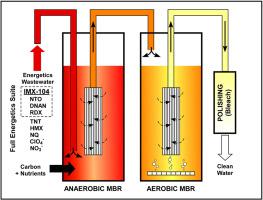Effective treatment of energetic containing wastewater in a sequential anaerobic-aerobic membrane bioreactor (MBR) system - Part 1: Treatment of IMX-104 wastewater
IF 8.1
2区 环境科学与生态学
Q1 ENVIRONMENTAL SCIENCES
引用次数: 0
Abstract
The treatment of wastewater containing the new insensitive energetic formulation IMX-104, which consists of the legacy explosive RDX and insensitive high explosives (IHE), 2,4-dinitroanisole (DNAN) and 3-nitro-1,2,4-triazole-5-one (NTO), was evaluated using a dual anaerobic-aerobic membrane bioreactor system. RDX and DNAN in the wastewater were completely degraded in the anaerobic MBR, with no observed production of common reduced daughter products (e.g., MNX, DNX or TNX for RDX and 2-ANAN, 4-ANAN, and DAAN for DNAN). NTO concentrations as high as 2 g L−1 were biotransformed predominantly to 3-amino-1,2,4-triazole-5-one (ATO) in the anaerobic MBR. The ATO degrading capacity of the aerobic MBR was exceeded at the high NTO concentrations, but subsequent polishing with 5 % sodium hypochlorite (∼4000 mg L−1 free chlorine) resulted in complete ATO removal. Electrochemical oxidation and UV/H2O2 treatment was also demonstrated to be effective for removal of residual ATO. The dual MBR system was fed a broader mixture of munitions constituents during some phases of operation, including HMX, TNT, nitroguanidine (NQ), perchlorate, and nitrate, and was observed to biodegrade these compounds even after a 90-day period when they were absent from the influent (i.e., during IMX-104 treatment). The dual MBR with sodium hypochlorite polishing proved to be highly effective for treatment of IMX-104 wastewater, as well as for removal of a variety of other munitions constituents.

顺序厌氧-好氧膜生物反应器(MBR)系统中含能废水的有效处理。第1部分:IMX-104废水的处理
采用厌氧-好氧双膜生物反应器系统,研究了由传统炸药RDX和不敏感烈性炸药(IHE)、2,4-二硝基异唑(DNAN)和3-硝基-1,2,4-三唑-5-酮(NTO)组成的新型不敏感能药配方IMX-104对废水的处理效果。废水中的RDX和DNAN在厌氧MBR中被完全降解,未观察到产生常见的还原子产物(例如RDX产生MNX、DNX或TNX, DNAN产生2-ANAN、4-ANAN和DAAN)。在厌氧MBR中,高达2 g L−1的NTO主要生物转化为3-氨基-1,2,4-三唑-5- 1 (ATO)。在高NTO浓度下,好氧MBR的ATO降解能力被超过,但随后用5%次氯酸钠(~ 4000 mg L - 1游离氯)抛光导致ATO完全去除。电化学氧化和UV/H2O2处理对去除残余ATO也有效。在操作的某些阶段,双MBR系统被注入了更广泛的弹药成分混合物,包括HMX、TNT、硝基胍(NQ)、高氯酸盐和硝酸盐,并且观察到即使在进水中没有这些化合物的90天后(即在IMX-104处理期间),这些化合物仍能被生物降解。双MBR与次氯酸钠抛光被证明是非常有效的处理IMX-104废水,以及去除各种其他弹药成分。
本文章由计算机程序翻译,如有差异,请以英文原文为准。
求助全文
约1分钟内获得全文
求助全文
来源期刊

Chemosphere
环境科学-环境科学
CiteScore
15.80
自引率
8.00%
发文量
4975
审稿时长
3.4 months
期刊介绍:
Chemosphere, being an international multidisciplinary journal, is dedicated to publishing original communications and review articles on chemicals in the environment. The scope covers a wide range of topics, including the identification, quantification, behavior, fate, toxicology, treatment, and remediation of chemicals in the bio-, hydro-, litho-, and atmosphere, ensuring the broad dissemination of research in this field.
 求助内容:
求助内容: 应助结果提醒方式:
应助结果提醒方式:


